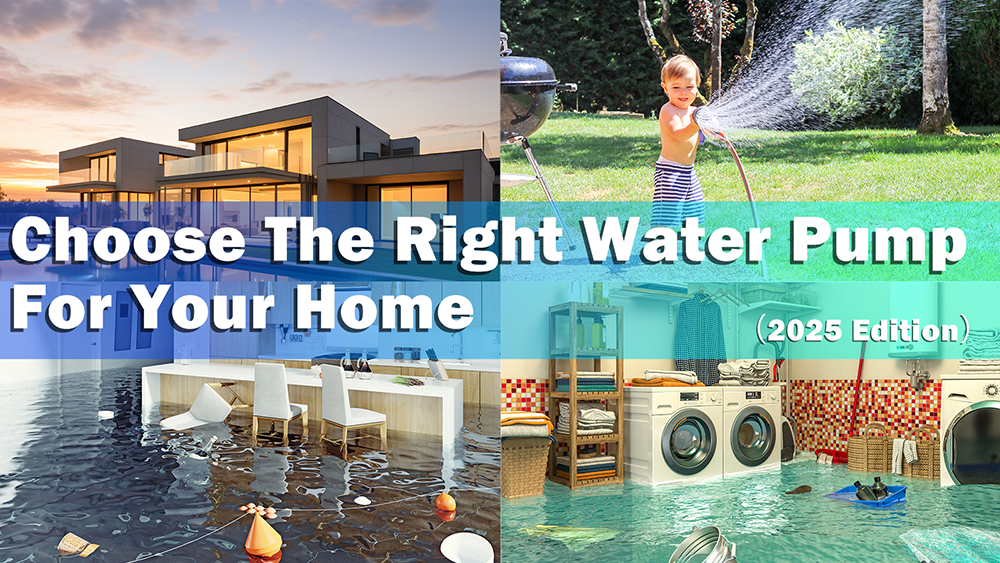+86 13816508465
Feb. 21, 2025

Choosing the right water pump for your home is essential for ensuring efficiency, reliability, and long-term savings. There are various types of pumps available, each suited for different purposes—whether you're looking to improve water pressure, circulate water, pump sewage, or manage water in your garden. In this guide, we'll cover the most common water pumps for residential use, including booster pumps, circulation pumps, sewage lifting pumps, and submersible pumps for your garden.
1. Understanding Water Pump Basics
Water pumps are devices designed to move water from one location to another. In homes, pumps are typically used for improving water pressure, circulating water, draining unwanted water, and managing wastewater. When selecting the right pump, it's important to understand the type of system your home needs.
2. Booster Pumps: Improving Water Pressure
If you've ever experienced low water pressure in your home, a booster pump might be the solution. These pumps are used to increase the water pressure coming into your home, ensuring that water flows effectively through showers, faucets, and appliances.
When to Choose a Booster Pump:
Low water pressure from your municipal water supply or well.
Areas of your home (like upstairs bathrooms) have weak water flow.
Need to maintain consistent pressure for showers, irrigation, and household appliances.
Key Features:
Helps deliver high water pressure to different parts of the home.
Often comes with an automatic pressure switch to activate the pump when needed.
3. Circulation Pumps: For Hot Water Systems
A circulation pump is used in homes to maintain a consistent flow of hot water throughout your plumbing system. This helps ensure that hot water is immediately available at all taps, without the need to wait for the water to warm up.
When to Choose a Circulation Pump:
You want to reduce water wastage from waiting for hot water to reach taps.
You have a large home where water takes a while to circulate to distant areas.
You want to ensure a constant supply of hot water for showers and faucets.
Key Features:
Reduces waiting time for hot water, improving convenience.
Energy-efficient models available to help save on utility bills.
4. Sewage Lifting Pumps: Managing Wastewater
A sewage lifting pump is designed to lift wastewater from lower areas (such as basements or crawl spaces) to a higher point where it can flow to the sewage system. These pumps are essential for homes located in areas with low drainage or where wastewater needs to be pumped uphill.
When to Choose a Sewage Lifting Pump:
Your home has a basement or is below the level of the main sewage line.
You're experiencing flooding or water accumulation in your basement or other low-lying areas.
You need a pump to handle wastewater and sewage from toilets or appliances.
Key Features:
Can handle solids and debris, making them ideal for wastewater.
Available in different sizes and capacities to suit various household needs.
5. Submersible Pumps: Garden and Floodwater Management
For homes with gardens, submersible pumps are a great option for removing excess water. These pumps can be used in ponds, pools, or to drain flooded areas. They work by being submerged in the water, allowing them to move large volumes of water efficiently.
When to Choose a Submersible Pump:
You need to drain water from your garden, pool, or pond.
Your property is prone to flooding or waterlogging.
You're using a water pump for irrigation in your garden.
Key Features:
Waterproof and designed to operate underwater.
Perfect for draining pools, ponds, or flooded areas.
Compact and efficient for garden irrigation and water drainage.
6. Choosing the Right Pump for Your Needs
Now that you have an understanding of the different types of water pumps, the next step is determining which one is best suited for your home. Here are some factors to consider when making your decision:
Flow Rate:
The flow rate refers to the amount of water a pump can move over a given period. If you need a pump for general water pressure or circulation, a higher flow rate will be required. For garden irrigation or draining purposes, consider a pump with an adequate flow rate for the job.
Head Height:
Head height is the maximum height a pump can lift water. For pumps used in sewage or wastewater management, the head height determines how far the water can be lifted to reach the drainage point.
Pump Capacity:
The capacity of the pump will depend on the size of the area you need to pump water from or to. Larger homes or areas with high water usage require a pump with higher capacity.
Energy Efficiency:
Choose an energy-efficient pump to save on electricity costs. Many pumps now come with energy-saving features such as variable speed motors and automatic shut-off mechanisms.
Installation and Maintenance:
Consider how easy it is to install and maintain the pump. Some pumps require professional installation, while others are designed for DIY installation. Regular maintenance is also essential for ensuring longevity.
Conclusion
Choosing the right water pump for your home can improve water pressure, prevent flooding, ensure reliable sewage disposal, and even optimize water use in your garden. Whether you need a booster pump for your plumbing, a circulation pump for hot water, a sewage lifting pump for wastewater, or a submersible pump for draining, there is a perfect pump to meet your needs.
By considering factors such as flow rate, head height, pump capacity, and energy efficiency, you can make an informed decision. If you're unsure, it's always best to consult a professional to help you select and install the right pump for your home.
Address
No.17 XeDa Jimei Ind. Park, Xiqing Economic Development Area, Tianjin, China
Telephone
+86 13816508465
QUICK LINKS